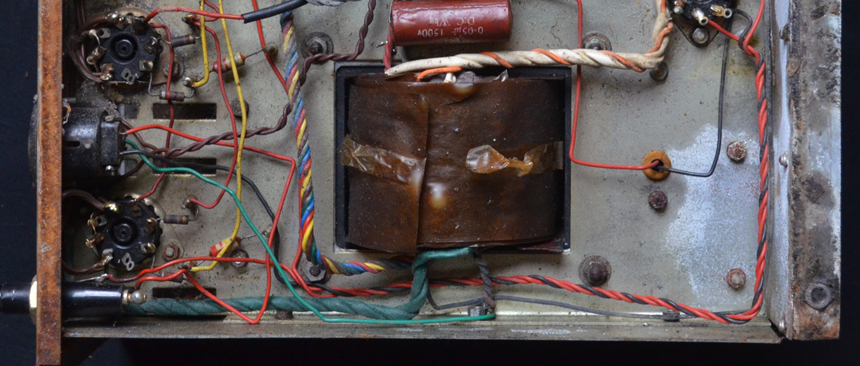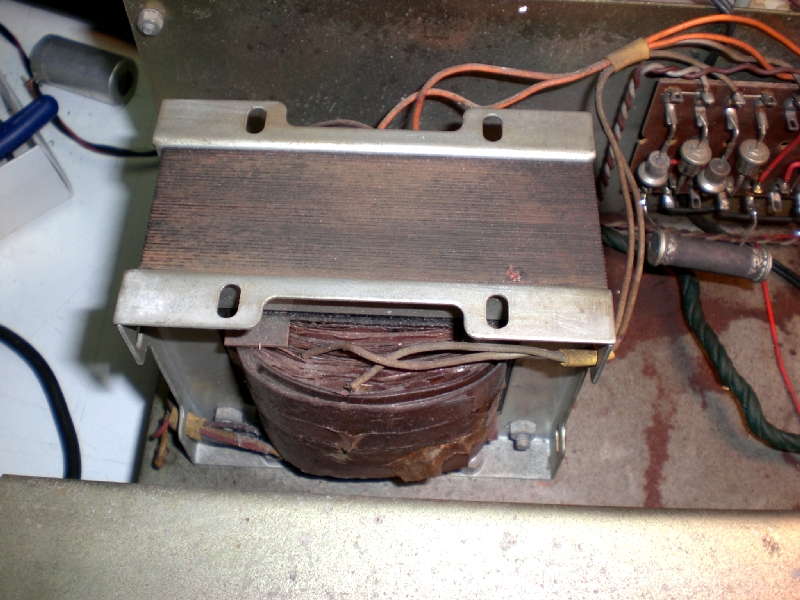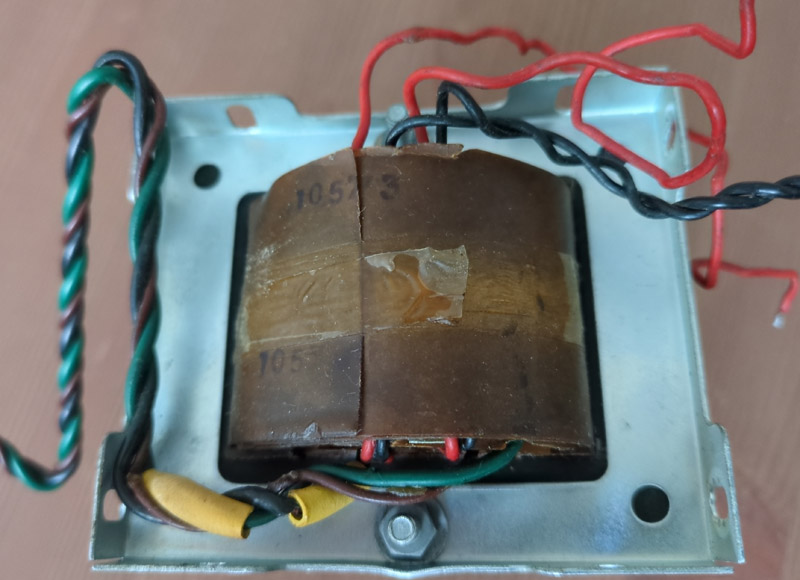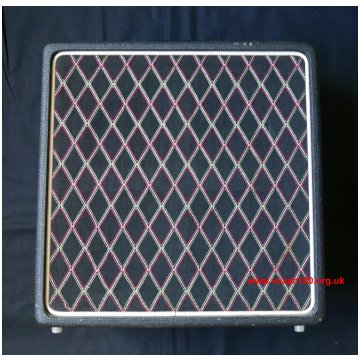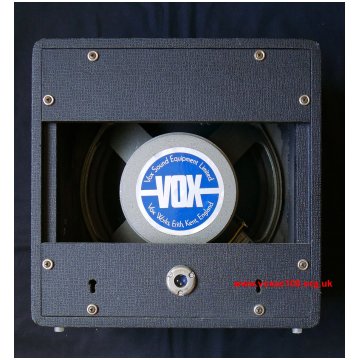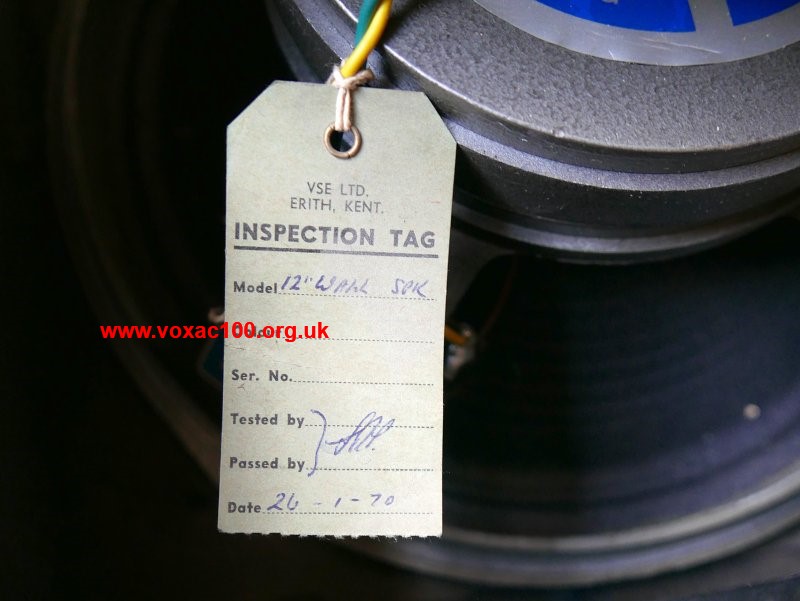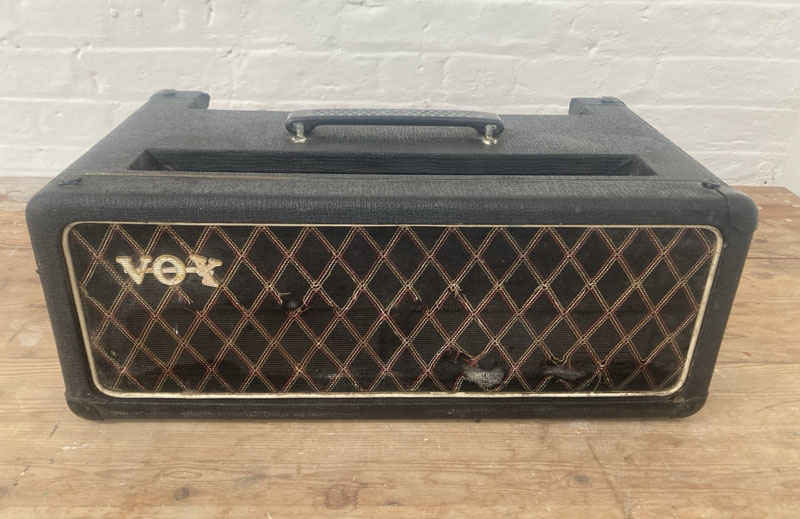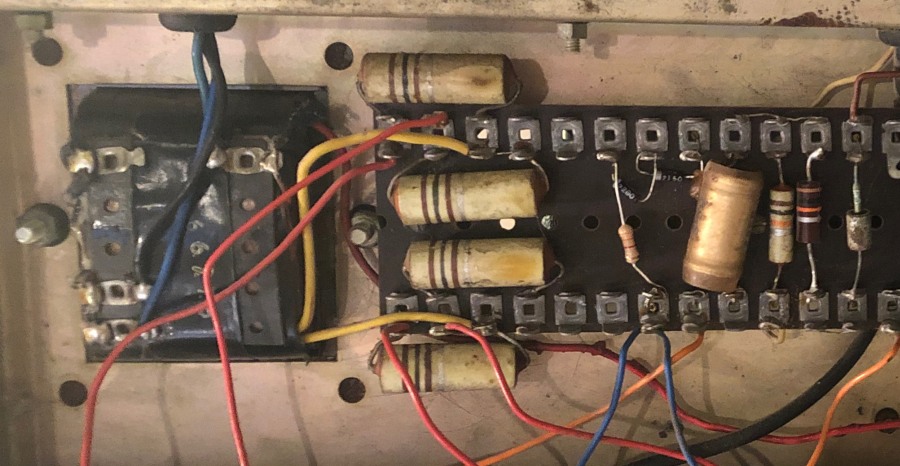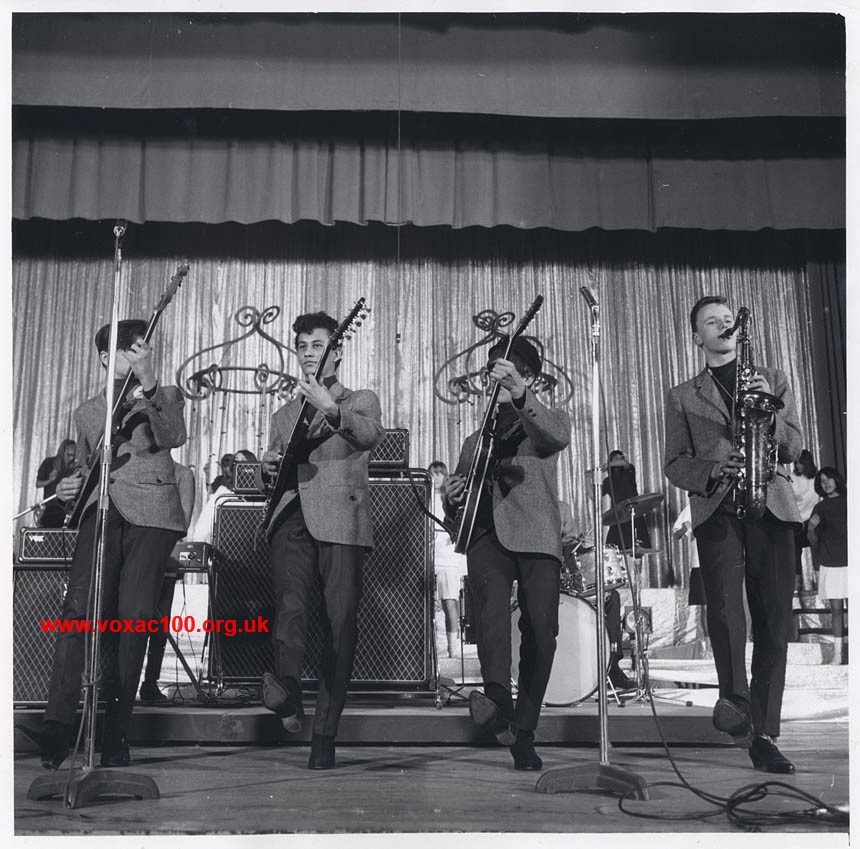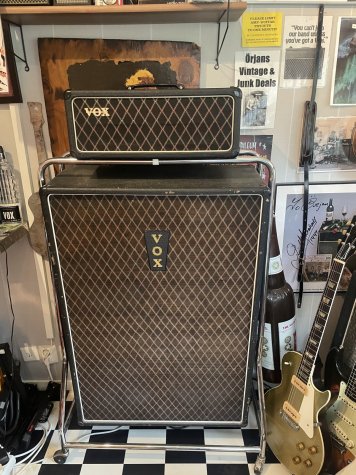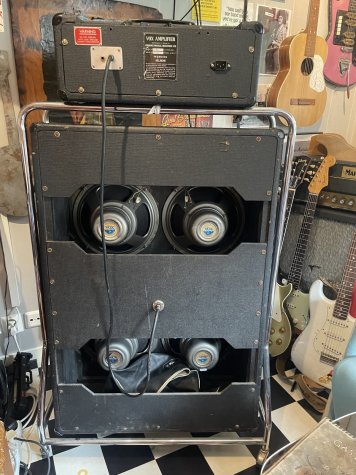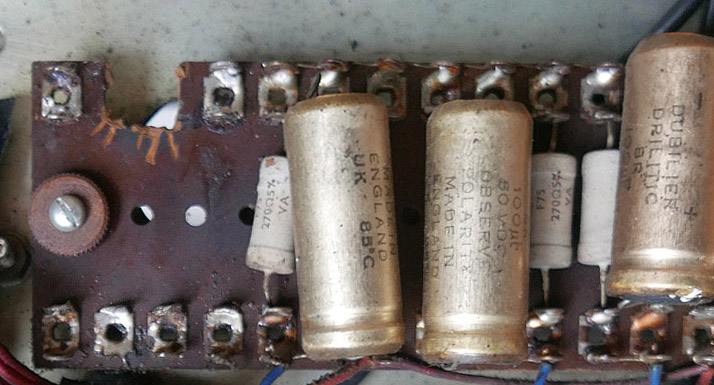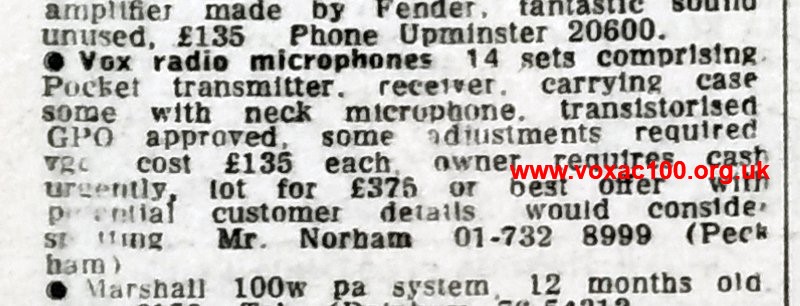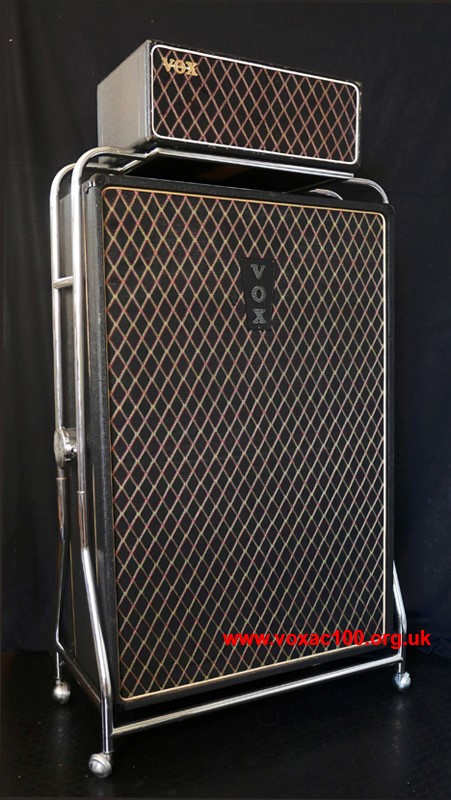VOX AC100 - UPDATES AND NEW INFO
2025
20th November
A little more on the batches of transformers used by Triumph Electronics for the AC50s, AC100s, 4- and 7-series amps, and PA amplifiers it assembled for JMI, 1964 to early 1967. A key characteristic is the use of sellotape to secure the outer wrap. In some instances one can see where the wrap joins - especially in the case of MC50s and MC100s, which generally have no shrouds (end bells). Not a single example has come to light so far of the use of sellotape by Drake.
See the entry below, 17th November, for Carl Nielsen's recollection of the transformers used for the 4- and 7-series amps.
AC50 serial number 1015, early 1964, output transformer, stamped on its underside "714216", sellotape gone but its shadow still evident. The transformers of AC50s produced by Triumph from 1964 into 1965 normally had (when new) paper stickers bearing the part number, in the case of the output transformer "JMI D008A".
MC100, late 1964, mains transformer.
Vox UL 730 serial number 3039, mid 1966, mains transformer, the sellotape just visible.
MC50 serial number 2666, early 1965, output transformer stamped "10573". The output transformers of AC50 guitar anplifiers had at this time the stamp "105736".
Triumph-made AC100, 1966/1967, mains transfomer, stamped "111961".
18th November
Some shots of the preamp assembly of the MC100/6 with the blue case. Details from another amp can be found on this page.
Six assemblies for the channels, a larger one for the master volume and meter circuitry.
Date code of the Egen potentiometer "AO" = January 1967 for its manufacture.
17th November
Notes on the transformers sourced by Triumph Electronics for the Vox Metal Clad 100 watters which the company assembled under contract for JMI from 1964 to late 1967. The transformers were for the most part open-frame - i.e. no shrouds (end bells).
Late 1964 and earlier 1965: - Douglas or early Drakes? The transformers of early MC100/4s (from late 1964) have paper stickers with the part number typed on: output = "D55 O/1"; mains = "D45 M/1". For pictures, see this page. "O" and "M" are obviously "Output" and "Mains". The earliest known MC100/6 also has an output transformer designated "D55 O/1".
Later 1965 and 1966: - transformers also with small paper stickers, a four digit number beginning with "7" typed on. The mains transformer of an MC100/4 from early 1966 has "112301" stamped on its underside; the choke has a paper label with "7144".
Note that Triumph also fitted the Vox 4-series and 7-series amps with transformers from this supplier. Carl Nielsen, who worked for Triumph from 1966, recalled that these transformers came from Douglas Transformers in Louth (Lincolnshire).
Some Vox MC50s had Woden chokes and mains transformers.
The stamped underside of the mains transformer of an MC100/4 from early 1966 - "112301". AC50 transformers were also stamped with six digit numbers in 1964 and 1965.
From early 1967: - Drake transformers, immediately identifiable by their heavy varnish and stamped numbers beginning "1202-" and "1204-". The transformers are slightly different in format and size from the transformers used by Triumph earlier on.
The MC100/4 has mains "1204-66A"; output "1202-111"; and choke "352-169". The MC100/6 has mains "1204-66B"; output "1202-111"; and choke "352-169". The style of the codes will be instantly recognisable to all those familiar with Marshall amps.
The MC100/6 with the blue case pictured in the entries below has transformers of the earlier format and size (i.e. as still current in 1966). The other three MC100/6s from 1967 have Drake transformers.
The power section of an MC100/6 from later 1967 - Drakes. The lamination stack of the mains transformer measures: 4 5/8" x 3 13/16" x 3" - compare these dimensions with those of the mains transformer of the MC100/6 with the blue case (posted on 14th November, below).
Douglas Electronic Industries (Douglas Transformers), as its website notes, was set up in 1948, adverts placed only sporadically in trade journals during the 1950s and 1960s. Drake began c. 1960, a good number of ads placed in mainstream electronics and wireless magazines.
April 1961.
16th November
Further pictures of the MC100/6, the underchassis carefully restored a few years ago. The two speaker sockets are currently tied together on the 8 ohm tap.
The top of the case with the preamp assembly removed: 19 7/8" x 13 1/4". When in place the preamp assembly protrudes a further 1/4" (so depth = 13 1/2", as noted below).
Underchassis, power section.
15th November
Some facts and figures relating to the Vox MC100/6: 19 7/8" wide; 13 1/2" deep; and 9 3/4" tall ignoring the case feet. It appears that Jennings did not publish dimensions for the metal-clads after 1965.
Weight is just over 4 1/2 stone = 29kg. Just imagine how heavy the MC150 would have been.
Also to note that the amp pictured in yesterday's entry is the only one of the four currently known to have two rather than four speaker sockets, one for 8 ohms, the other for 15 ohms, and no impedance selector. It is likely that two principal types of set-up were envisaged: (i) two cabinets of 15 ohms each - Line Source 60 columns (?) - daisy-chained (in parallel) into the 8 ohm socket; or (ii) four speakers of 4 ohms each run in series into the 15 ohm socket.
Line Source 40 and 60 columns could be wired for a total impedance of 4 rather than 15 ohms.
Detail of the MC100/6 illustrated yesterday.
Detail of one of the other three MC100/6s (identical arrangements).
The only cabinets in JMI's 1967 catalogue that would have been capable of handling 100 watts or more on their own were the AC100 SDL / Supreme and the Super Foundation Bass, none of which would have been much good for public address.
Below, the preamp assembly with an MC100/4 assembly on top simply to give a sense of width.
14th November
Thanks to Mick, the mighty power section of a Vox MC100/6 from early to mid 1967. The lamination stack of the mains transformer measures 5 1/4" x 4 3/8" x 3".
Pictures of the whole to follow soon, along with a note of the MC100/6's weight (not light).
Below, a detail of a photo taken in one of the testing rooms in the West Street Works by Denis Molyneux at some point in 1967. On the bench, pre-production fully solid state PA amplifiers and a transformer marked "MC100 /6 or /4 MAINS". The end bells were generally not retained on production MC100/6s.
On the piece of tape, a four digit number beginning "72". The choke of the MC100/6 pictured above has "7144".
2nd November
Thanks to Martin, front and back of the JMI instruction card for the Line Source 15 and Line Source 40 column speakers, in terms of this printing, prior to late 1965 as the LS60 is not in view.
31st October
Entries for two AC100s from 1966 have been added - serial number 1374, early in the year, and number 1739, towards the end. Further entries to come shortly - three "100 Watt Amplifiers" and an early Mark 2, all later 1965.
6th October
An entry has now been created here for the AC100 illustrated below on 20th September.
30th September
Local press, late January 1967, a double spread on the West Street Works at Erith, the famous picture of the final assembly / dispatch hall (top left) printed in full.
"Twang Goes a Million" - the West Street Works.
23rd September
Probably one of the last Vox 12" wall speakers to have been been prepared for sale (and sold) - signed off on a "Vox Sound Equipment Limited" tag on 26th January 1970, the company that succeded it - "Vox Sound Limited" - having just come into being. The speaker is a Fane 122/17.
The main page on portable / wall speakers can be found here.
20th September
Recently sold in the UK, a well-used AC100 mark 2, chassis number 1596, a serial number probably originally somewhere in the high 700s or 800s, September/October 1965. Mains transformer and choke renewed. Further pictures to follow.
18th September
Thanks to Keith, further images of AC100 serial number 1657, second quarter of 1966, have been added here. The amp is one of a small number to preserve its original plate resistors, 1-2W Eries in this case.
Original Erie 100 ohm plate resistors.
7th September
"The Overtures", Milwaukee, January 1966, with two AC100s and a small-box AC50 Foundation Bass perhaps provided for the event by Thomas Organ.
"The Overtures", January 1966.
23rd August
Thanks to Örjan, pictures of serial number 1119 with an AC100 SDL speaker cabinet brought together from various sources.
AC100 serial number 1119 with an SDL cabinet.
22nd August
AC100s "blowing up". Who knows where the myth started - probably with someone who had an innate liking of exaggeration. "It just blew up mate, they ALL just blow up".
That said, a good number of early 100 watt amps did have a weak point - their plate resistors. Marshalls, as well as Vox, Fender, Selmer, and so on. Numbers of these resistors evidently flamed out. Where AC100s are concerned, one can often see the tell-tale scorch marks on the tagboard, everything else - transformers, bias and screen resistors - perfectly OK.
Detail of an early AC80/100, the plate resistors having flamed out at some point. The transformers, cathode bias network, and original EL34s (which still work, though obviously not "as new") were completely unaffected.
As for those plate resistors that did not flame out - the greater proportion of amps - diligent servicing in the 1970s and 1980s generally saw their removal.
Below, an overview of the types of resistor used by Westrex and Burndept, the two main contractors charged with assembling the chassis:
Copper and black panel cathode biased AC100s: assembled by Westrex. So far no amp has come to light with its original plate resistors in place. It seems likely that they were the 1/2 watt Dubiliers used by Westrex in the preamp.
Grey panel cathode biased AC100s: assembled by Burndept. Plate resistors were 1/2 watt Eries (as in the preamp). These can be seen in serial numbers 323, 392, and a handful of others.
Grey panel fixed bias AC100s: assembled by Burndept. Plate resistors changed to large 1 watt Eries. Plenty of examples can be seen in surviving "100W Amplifiers", JMI's first version fixed bias AC100.
16th August
A further Vox MC150 Public Address amplifier "out in the wild" accompanied by four column speaker units (each containing four speakers) - "Exchange and Mart" magazine, London edition, April 1969:
April 1969.
7th August
Exchange and Mart, London edition, December 1968, a seller with 14 sets of Vox Radio Microphones, some evidently more complete than others. Although nothing is said about how they came to be in his hands, the likelihood is that he acquired them at the final JMI liquidation sale - held at the Vox Works in Erith - in early September 1968.
December 1968.
5th August
From around serial number 1200, a new style of red warning plaque comes in, WARNING in larger letters, the lines of text underneath more widely spaced. It seems that supplies of the new type of plate were directed initially mainly to the AC50. After a sort of false start with the new red ones, AC100s were given white plaques again (an older type) as a stop-gap from serial numbers in the high 1200s to the high 1300s. The new style of red plaque became standard thereafter.
Where AC50s are concerned, the new style of plate came in around serial number 5500.
Serial number 1099.
Serial number 1216.
23rd July
Thanks to Chris, some shots of AC100 serial number 750, an early Mark 2 (fixed bias) amplifier. Further instances can be found on this page.
AC100 serial number 750.
21st July
One of the Super de Luxe speaker cabinets from late December 1964 / very early 1965 with a thin-edged AC80/100 from late autumn 1964:
19th July
Thanks to Christian, further pictures of MC50 serial number 2666, ready for sale in the Spring of 1965, can be seen on this page.
MC50/4 serial number 2666.
14th July
Picking up from yesterday, the next earliest amp after AC100 serial number 392 known to survive with its original shielded speaker cable in place is serial number 448:
Detail of AC100 serial number 448, the original cable just holding on. The two white wires were added sometime later.
13th July
More often than not when one finds an AC100, its internal speaker cable has been replaced - ie. the cable leading from the terminal block to the socket on the back panel. The same goes for early AC50s. Why? JMI - unusually - used shielded/screened single core (outer diameter 5/32").
Techs and subsequent owners probably took one look at it and thought "no, that can't be right", fitting two core cable in its place - often old lamp cable in the UK.
Below, a detail of AC100 serial number 392, still in original state. Serial number 520 also has its original cable, along with an early two-input AC50 now without its serial number plate.
Serial number 392. Shield/screen is common, the insulated core "positive".
A length of cable belonging to another amp.
The cable is reckoned to have been made by Permanoid, based in Manchester. JMI, Burndept, Triumph, and Westrex went through drums and drums of it over the years. The cable was also used by JMI for footswitches, shorter guitar leads, and so on.
During the course of later 1964, AC50s were wired up with more traditional speaker wire, lengths of yellow and green, 24/02.
4th July
Thanks to Christian, some superb pictures of Vox MC50 serial number 2666 coming soon. The main overview page on the model can be found here.
25th June
Thanks to Bob Valentine, a shot of his band "The Clockwork Oranges" on stage, mid 1960s, two AC30s and a Foundation Bass cabinet in view.
21st June
Thanks to Jonathan a great shot of three Jennings items (really two as the J100 and D4 speaker cabinet go together): Jennings AC100 serial number 2031, and J100 serial number 1233. The cab has its original Celestions, all with January 1970 date codes.
11th June
To note, thanks to Tom, that AC100 serial number 2128 has come to light, produced in late 1967, JMI circuit diagram OS/167, one ECC82 and two ECC83s in the preamp, four filter capacitors on the upper chassis. The latest visible component date code is the Woden choke "HY" = August 1967. The amp was evidently sold in the UK. Many later amps were exported (particularly to Germany and Holland) - some are registered on this page. Pictures and further details to follow.
16th May
Thanks to Danny, a couple of shots of Jennings AC40 serial number 1215, ready for sale in late 1971. The page on the AC40 can be found here.
8th May
Below, thanks to Martin, a detail from a photo taken at the Russell Hotel Trade Fair in August 1965 showing among other things the rear of one of the new Vox Line Source 40 public address speaker columns with built-in transistor amplifier.
It is not immediately obvious where the mains cable plugged in. The rectangular socket at the base of the column looks to be a standard XLR rather than a Cannon LNE-32.
Review of the Fair, published September 1965.
4th May
An entry has been created for AC100 serial number 714, a late "100 Watt Amplifier". Pictures to follow shortly.
11th April
Part of a longer piece on Tom Jennings, mainstream Liverpool press, September 1964, the Beatles having been in the USA for near on three weeks. The group had a backup/spare AC80/100 amplifier section and Mal Evans a plentiful supply of replacement valves. There were however only three speaker cabinets (and trolleys) - one bass, two SDLs - the ones used and seen on stage.
It would presumably have been perfectly possible to replace anything damaged at one concert in time for the next.
15th September 1964.
10th April
Searches through various repositories of newspapers in the United Kingdom have brought to light - so far - a grand total of no adverts (listings) for the AC100 from local shops in the "provinces", i.e. outside London.
Some of the material from shops in London can be found on this page - to be updated soon.
6th April
Copied over from the Vox AC30 website, one of the earliest adverts for Vox in America illustrating equipment recently arrived (i.e. not simply reprinted from a photo supplied by JMI) - 1st November, 1964.
Left to right: an LS40 column; AC4; AC50 Foundation Bass; and an AC10 Twin. The guitars are: Vox Clubman; Dominator; Symphonic Bass; and Super Ace. The Clubman's hang-tag can be seen at left.
More to come on Vox in the USA shortly.
Cleveland, November 1964.
2nd April
Pics of serial number 2025 - a bass set from 1967 - have now been added on this page.
19th March
Thanks to Alan, pictures of an early AC80/100, mid or later 1964, its back panel replaced at some point with one from a later amp - serial number 1799. More to come shortly.
8th March
The firm that assembled the new solid state PA100 for Jennings (Jennings Electronic Industries) in 1973 evidently produced versions of the same amp for at least two other companies, the two currently known being Colorsound and FAL.
The version made for FAL normally had two sets of inputs for each of the first three channels, but no push buttons. As for the company that made the amps for Jennings, Colorsound, and FAL, the two chief runners would seem on the face of things to be Triumph Electronics (Purley) and A.P.T. Electronics (Byfleet). On balance, the latter feels more likely - in the mid 1970s Triumph concentrated mainly on valve amps.
Chassis with reverb tray mounted on top.
Colorsound PA100, reverb tray mounted with springs down.
A slightly different version of the board produced for the Jennings amplifier.
7th March
A Vox trade show wallet perhaps from the Russell Hotel Fair of August 1963. The "Guitar Accessories" brochure is part of a series of five covering various aspects of the Jennings range. The xerox is a copy of the catalogue of late 1963.
3rd March
The page on the Jennings J40 combo is in the process of being updated, new material from Dave M. and Steve W. - thanks to them - to be incorporated. A note will be posted when the updates have been fully worked in.
22nd February
A little on the sound testing of the AC100 SDLs produced for the Beatles, thanks to Geoff, who was present. The testing took place in the main assembly area of 115 Dartford Road, early August 1964. A number of the skylights in the sloping roof were opened, presumably to help disperse the pressure. Also present were Alan Pyne (who looked after repairs and the Artists' Loans Shed); Dick Denney; Derek Underdown; and various others. The volume was so immense in the confined space - certainly confined in relation to the stadiums in which the amps would be used a few weeks later - that Geoff had to stand at the far end of the area.
Reg Clark, JMI's General Sales Manager, also remembered the SDLs being tested outside the Dartford Road Works - reported by Jim Elyea, page 588 of his book. Perhaps the same day slightly later on (?).
The new SDLs were delivered to John and George on 9th August at Scarborough. The equipment went up from Dartford in the JMI van, probably driven by Ernie Sleight, Eddie Haynes (sales rep. for the south-east of England) a passenger. Dick Denney drove up in his mini, accompanied by his wife Dolly, and Alan Harding, his assistant. More can be found on this page. The picture below of John trying out the amp before the concert was taken by Eddie Haynes.
9th August, 1964.
3rd February
A plan of the first floor of the Russell Hotel, British Musical Instrument Industries Fair, August 1967, from a BMII brochure picked up there by Don Miller. Thanks to Martin for the photo.
Jennings had five rooms on the floor: 134A, 135 for organs (probably along with 134A), and 141-143.
Below, Don's name in the list of Thomas dealers who went on the trip to Europe, published in Billboard magazine, October 1967. His main shop was indeed in Graham, North Carolina, where Thomas sent the bulk of its material for his displays, not Elon (corrected in yesterday's entry).
2nd February
In August 1967, as a sort of fillip for its dealers, Thomas Organ arranged a European jamboree, timed to take in the BMII Trade Fair in London. One of the members of the tour was Don Miller, owner of Frank's Jewelry and Music in Graham, North Carolina. At the Fair, Don collected three wallets (among other things), kept over the years along with his Thomas Organ promotional material. One of the three - all are complete - is pictured below. A short piece on Don can be found here.
To date, stray items only from '67 Trade Fair wallets have turned up in the UK, and seemingly until now, in the USA too.
The Thomas Organ dealers, photographed before boarding their plane, Don somewhere in the crowd.
Detail from a photo of the JMI stand at the London Trade Fair, a small stack of wallets on the PA amplifier.
The wallet with Marauder brochure at front.
1st February
Below, the contents of the Trade Fair wallet illustrated in yesterday's entry: brochure for the Marauder Special guitar; flyers for the new ranges of organs and Gyrotone rotary speaker cabinets; the new JMI catalogues for amplifiers and guitars; wah-wah pedal demonstration flexi disk (removed from its backing card); select pages from the 1966 catalogue; "Vox Parade" double-sided "newsletter".
Tomorrow, the story of the wallet - how it came to be in the USA (until recently).
31st January
Thanks to Jim and Martin, a shot of one of the JMI promotional wallets handed out at the BMII Trade Fair in August 1967. More to come shortly. A page on JMI's presence at the Fair can be found here.
24th January
A couple of pictures to illustrate how serial number plates were attached on Vox "Metal Clad" public address amplifiers - with araldite. Many doubtless came off early on, the result of being heaved in and out of vans.
Underside of a MC50 amplifier from 1965.
Underside of a MC100 amplifier from late 1964, plate gone, only the swirls of araldite remaining.
23rd January
Just to note that pictures of AC100 serial number 736 (00736) have recently been posted on FB. The entry for the amp - on this page - has been updated.
20th January
Thanks to Angel, pictures of a Triumph / Jennings AC100 from later 1971, possibly 1972, in superb original condition. The amp is one of a number sold without logo and serial number plate. The main page on the Jennings AC100 can be found here, the amp below pictured in the section towards the end of the page.
19th January
Thanks to Marc, a couple of new pictures of AC100 serial number 496, late summer 1965.
8th January
Two further sightings of early JMI Line Source 60 public address speaker columns (4 x 12"), late 1965 / early 1966, a single with the shop plaque of "Musikhaus Hummel" in Frankfurt but currently in the USA, brown grille cloth, type of speakers unknown; and a set of two, currently in Europe, original stands present. All three have the distinctive band (dropped later on) across their fronts. More on Line Source 60s can be found on this page.
Thanks to Kevin for signalling the existence of this column. If the brown grille cloth is original, which it may (just) be, then a very late instance.
Thanks to Joop.
2024
29th December
Vox Line Source 40 (LS40) public address column speakers in America, late 1964 to late 1965. The earliest dated picture that has come to light so far is from March 1965 (below). The LS40s in view are English-made, flown over to the US for the Thomas Organ Company to distribute and sell:
March 1965, pictured with Hal's Vox AC4 and Stroller guitar.
The columns will have had "Jennings Musical Industries" identification plates on their backs, no mention of Thomas Organ. An overview of JMI's production can be found on this page.
For its catalogues, Thomas, as was its wont, gave the columns a fancy "Swinging London" name - the "Grenadier" - and designated the model for its inventories as the "V-1-20". Below, a detail from the pricelist of April 1965:
In the pricelist of September the V-1-20 is $295.
Although English-made equipment remained the norm through to the autumn of 1965, Thomas had in the meantime made good progress with plans for its own production lines of Vox equipment, primarily to cut the costs of shipping (though that evidently was not the only reason). Dick Denney duly went to Sepulveda to advise. The story of Dick's time there in late October / early November 1965, and an outline of the various matters discussed, can be found in Appendix 3 of the "Vox Story", ed. Denney and Petersen (1993), which gives a transcript of the Thomas report of the visit - fascinating reading and key to understanding how Thomas got its own production going.
On page 144 the matter of speakers for Line Source columns comes up. The text is worth quoting:
"Various speaker samples were compared to those used by Jennings in this application [the LS40]. No American speakers were found amongst the available samples which gave identical tone and performance to the English version. Here it was not so much a case of speakers being better of worse, but it is our desire not to alter the present sound characteristic of the English unit. Speakers have been purchased from the English source for the first releases of domestic production and we will continue to sample speakers from domestic speaker manufacturers until a satisfactory equivalent is obtained."
The English speaker manufacturer was of course Elac, and these were fitted to the first American-made columns - the "V-9". Below, some examples. The columns have Thomas identification plates at back, standard Thomas textured vinyl (not basketweave), paper stickers inside bearing the serial number of each column, and Elacs, as mentioned. Thanks to Ihor for the first three pictures.
No serial number was stamped on this plate.
Column number 992082.
The V-9 is on the right: main case made of plywood, the baffle and back panel chipboard (particle board), replicating the construction of the English-made cabinets of 1965.
Details of another set of V-9s, pictures thanks to Glenn - the serial number 992323 machine-stamped on the metal plate:
Rear, showing the closed back.
The serial number plate.
The highest column number (on the paper stickers) known at present is 992999. If the sequence began at 990000, then Thomas is likely to have made and sold around 500 pairs from late 1965 to around mid 1966. If on the other hand the starting point was 992000, which is perfectly possible, then of course around 400 made. During the course of 1966 changes that are not really germane here were brought in, and the model redesignated as the "V-1091", which is perhaps the most familiar version of the model.
20th December
A note on white warning plaques. The earliest AC50s with known serial numbers - 1004 and 1005 - were fitted with a type of plaque (Type 1) visibly different from the type of plaque that came shortly afterwards and remained standard into 1965 (Type 2). The earliest Type 2 plaque known at present occurs on AC50 serial number 1028 [*not number 1034 as previously stated].
The AC50s issued to The Beatles and The Dave Clark Five evidently had no warning plaques of any sort.
Type 1 plaque, AC50 serial number 1004. The same type is also found on AC50 serial number 1005.
Type 2 plaque. AC50 serial number 1034.
The same quick transition from Type 1 to Type 2 can be seen on AC80/100s. Bill Wyman's first amp - serial number 150 - had a Type 1 plaque, the change to Type 2 taking place by serial number 162.
Type 1 plaque, Bill Wyman's first AC80/100. Although the print resolution is low, note the amount of white space above "WARNING".
Type 2 plaque, AC80/100 serial number 162.
Type 2 plaque, AC80/100 serial number 178.
25th November
Thanks to Phil, pictures of Jennings AC40 serial number 1197, speakers dated November 1971, can now be seen here. Pics of Jennings JV serial number 1188 to come.
AC40 serial number 1197 (at right) with JV40 serial number 1188.
22nd November
Copied over from the Vox AC30 website. Published in "Music Maker" magazine, April 1967, "The Beakles", miniature drum kit, AC30s, AC100, and guitars made by Mick Bennett of JMI. Mick was responsible for prototyping many of JMI's guitars, cabinets, and cases through to 1968.
19th October
Thanks to Daniel, pictures of AC100 serial number 2108, mid 1967, have been added here.
AC100 serial number 2108.
18th October
Just to add in relation to yesterday's entry, "Emihus" zeners first come in towards the end of 1965. Serial numbers 796, 902 and 917 still have gold-coloured zeners made by "International Rectifier".
17th October
Some notes on the bias circuit of the AC100 mark 2, later 1965 through to 1968.
Detail from the circuit diagram for the AC100 mark 2.
As in the "100W Amplifier" of late summer 1965, the bias voltage was clamped by a pair of zener diodes - see this page. For the AC100 mark 2, JMI turned to "Emihus", a subsiduary of EMI based in Glenrothes. The "Hus" part of the name was the original owner - Hughes International (UK), part of the Hughes Aircraft Corporation.
The 20v diode across the width of the board was a "HS2200", the 15v diode across the two solder terminals a "HS2150".
Detail of AC100 serial number 1579.
Below, a detail from the "Emihus" specification sheet, the columns left to right being: part number; zener voltage; tolerance (in %); max. zener current (unspecified); dynamic resistance (in ohms); max. dissipation (in mW); type of connection (A1 = axial, flying leads).
Detail from the Emihus spec. sheet.


